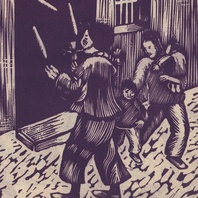
Item
Fengyang guniang (Maidens of Fengyang)
This woodcut, by an artist called Fang Wenxing, was reproduced in Zhonghua huabao (Chinese Pictorial) 1.4 (November 1943). The importance of the muke (woodcut) form to artistic practice in occupied China has been almost entirely overlooked in the literature. The muke form has hitherto been associated with the art of resistance in China, despite being an important part of “occupation” visual cultures as well.
Read More
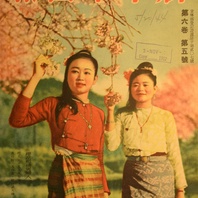
Item
Xin Zhonghua huabao (New China Pictorial) cover, May 1944
This cover image from the Xin Zhonghua huabao (New China Pictorial) 6.5 (May 1944) shows a photograph of two unnamed Burmese women. The New China Pictorial was a bilingual (Chinese-English) magazine published from 1939 through 1944 in Shanghai by the occupation journalist Wu Linzhi for distribution in China and throughout Southeast Asia. This magazine employed cover images of women from areas of Southeast Asia that had been conquered by Japan with increasing regularity over the course of 1943 and 1944, having previously focused on Chinese film celebrities.
Read More
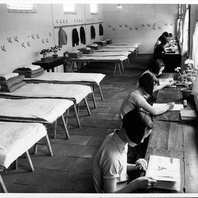
Item
Girls are all living in a dormitory [sic]
From a collection of staged photographs produced under the title “Life at a Girls School in Peking”, and produced at the Peking Jiyu Gakuen in Japanese-occupied Beijing. The original caption reads: “They are doing their ‘home works’ [sic]”.
Read More
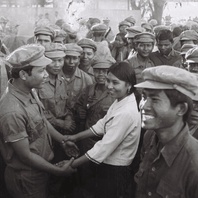
Featured Item
Brother and sister reunited
This unattributed photograph shows a brother and a sister being reunited after three years of separation. The siblings are in the centre of the image, he wearing a uniform, and she wearing what looks like festive clothing. They hold hands. The people around them, a mix of soldiers and civilians, smile broadly. The soldiers are from the Kampuchea United Front for National Salvation (KUFNS, also known as FUNSK) [Front or Renakse]. This image was featured in the publication (French and English versions) The People’s Republic of Kampuchea (1979). This photograph is part of the collection held by the Agence Khmère de Presse (AKP) and Cambodia’s Ministry of Information. This collection, which documents the early years of the People’s Republic of Kampuchea as photographed by the Vietnamese and a small team of Cambodian photographers, has not yet been classified or indexed.
Read More
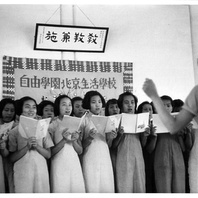
Item
A chorus group [sic]
From a collection of staged photographs produced under the title “Life at a Girls School in Peking”, and produced at the Peking Jiyu Gakuen in Japanese-occupied Beijing.
Read More
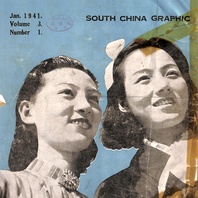
Item
Huanan huabao (South China Graphic) cover, January 1941
This cover image is taken from Huanan huabao (South China graphic) 3.1 (January 1941). The staged photograph deploys one of the standard tropes of Japanese propaganda in occupied China, i.e., that of a Japanese woman and Chinese woman fraternising with each other. This trope was derived from Manchukuo propaganda and the notion of “gozoku kyōwa” (“the harmony of the five races”), as well as attempts to feminise the image of an occupied China. Note how the Japanese woman is pictured as being slightly higher than her Chinese peer.
Read More
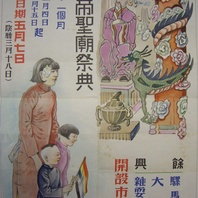
Item
Yaodi shengmiao jidian (Ceremony at the Emperor Yao Temple)
This poster was produced (almost certainly by the Japanese military) with the aim of advertising the re-opening of the Emperor Yao Temple (Yaodi shengmiao) in Linfen (Shanxi Province). This site was taken by the Japanese from communist resistance fighters, and was used by the Japanese as a symbol of the apparent iconoclasm and lack of religious sensitivity shown by the communists. The re-opening the temple to worshippers in the spring of 1938 by the Japanese was used to demonstrate the extent to which occupation supposedly included respect for Chinese religious traditions. The painted image of the female worshipper here was based on a photograph of a female worshipper at the same temple produced in other propaganda leaflets some months earlier.
Read More
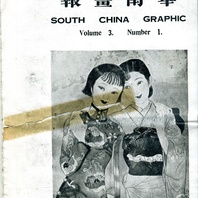
Item
Huanan huabao (South China Graphic) inside cover, January 1941
This image is taken from Huanan huabao (South China graphic) 3.1 (January 1941). The illustration deploys one of the standard tropes of Japanese propaganda in occupied China, i.e., that of a Japanese woman and Chinese woman fraternising with each other. This trope was derived from Manchukuo propaganda and the notion of “gozoku kyōwa” (“the harmony of the five races”), as well as attempts to feminise the image of an occupied China. Note how the Japanese woman is pictured as being slightly higher than her Chinese peer.
Read More
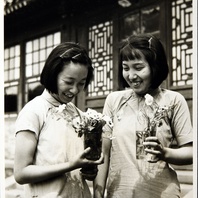
Item
Two girls picked flowers for the dinner table [sic]
From a collection of staged photographs produced under the title “Life at a Girls School in Peking”, and produced at the Peking Jiyu Gakuen in Japanese-occupied Beijing. The original caption reads: “Two girls picked flowers for the dinner table [sic]”.
Read More
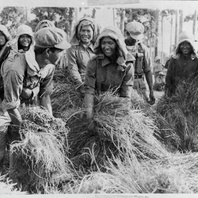
Featured Item
Soldier helping with harvest
This staged and unattributed photographs shows a soldier of the Kampuchea United Front for National Salvation (KUFNS, also known as FUNSK) [Front or Renakse] helping a group of women to harvest crops. In the foreground, the soldier, with his rifle on his back, makes a large sheaf. He looks at the woman on his left. This photograph is part of the collection held by the Agence Khmère de Presse (AKP) and Cambodia’s Ministry of Information. This collection, which documents the early years of the People’s Republic of Kampuchea as photographed by the Vietnamese and a small team of Cambodian photographers, has not yet been classified or indexed.
Read More
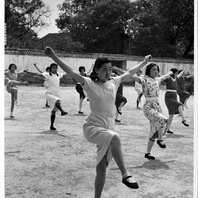
Item
Danish gymnastic [sic]
From a collection of staged photographs produced under the title “Life at a Girls School in Peking”, and produced at the Peking Jiyu Gakuen in Japanese-occupied Beijing. The original caption reads: “Some graduate of the Jiyu Gakuen were sent to Danmark [sic] in order to study the gymnastics, and now the Chinese girls are given the new type of physical training in China [sic]”. “Danish gymnastics” was a form of mass athletic exercise popular in Europe in the inter-war period.
Read More
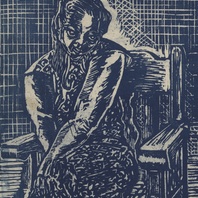
Item
Furen xiang (Portrait of a woman)
This woodcut, by an artist called Ma Wu (probably the most prolific of Chinese popular artists openly active during the Japanese occupation), was reproduced in Zhonghua huabao (Chinese Pictorial) 2.2 (March 1943). The importance of the muke (woodcut) form to artistic practice in occupied China has been almost entirely overlooked in the literature. The muke form has hitherto been associated with the art of resistance in China, despite being an important part of “occupation” visual cultures as well.